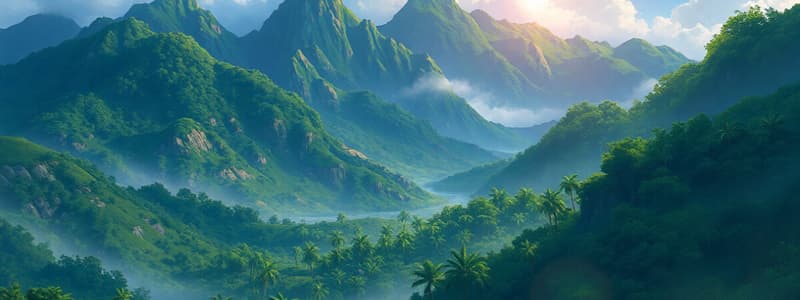Podcast
Questions and Answers
What primarily affects temperature in different zones?
What primarily affects temperature in different zones?
- Wind speed
- Soil type
- Population density
- Latitude, altitude, and ocean currents (correct)
Areas near the equator receive less sunlight than areas farther from the equator.
Areas near the equator receive less sunlight than areas farther from the equator.
False (B)
How do ocean currents affect climate?
How do ocean currents affect climate?
Ocean currents can be warm or cold, impacting the temperature of nearby regions.
The Philippines experiences a total of ___ distinct seasons.
The Philippines experiences a total of ___ distinct seasons.
Which of the following regions experiences the first climate type in the Philippines?
Which of the following regions experiences the first climate type in the Philippines?
In the second climate type in the Philippines, there is a pronounced dry season.
In the second climate type in the Philippines, there is a pronounced dry season.
What is the dry season in the first climate type in the Philippines?
What is the dry season in the first climate type in the Philippines?
Match the climate types of the Philippines with their characteristics:
Match the climate types of the Philippines with their characteristics:
Which of the following describes climate?
Which of the following describes climate?
Temperature and precipitation are the only factors that determine climate.
Temperature and precipitation are the only factors that determine climate.
What are the two natural factors that affect the amount of precipitation in an area?
What are the two natural factors that affect the amount of precipitation in an area?
The _____ side of a mountain range receives more precipitation due to moist air.
The _____ side of a mountain range receives more precipitation due to moist air.
Match the following climate zones with their descriptions:
Match the following climate zones with their descriptions:
What happens to warm air when it rises?
What happens to warm air when it rises?
What is precipitation?
What is precipitation?
Latitude is a factor that affects temperature.
Latitude is a factor that affects temperature.
Which region in the Philippines experiences a relatively dry season from November to April?
Which region in the Philippines experiences a relatively dry season from November to April?
The phenomenon known as La Niña results in warmer than usual sea surface temperatures.
The phenomenon known as La Niña results in warmer than usual sea surface temperatures.
What is the primary characteristic of the fourth climate type in the Philippines?
What is the primary characteristic of the fourth climate type in the Philippines?
The __________ effect is a natural process that warms the Earth's surface by trapping heat.
The __________ effect is a natural process that warms the Earth's surface by trapping heat.
Match the climate types to their descriptions:
Match the climate types to their descriptions:
Which climate type is prevalent in most of Central, Eastern, and Southern Mindanao?
Which climate type is prevalent in most of Central, Eastern, and Southern Mindanao?
El Niño occurs when winds causing upwelling blow strongly.
El Niño occurs when winds causing upwelling blow strongly.
Name two large-scale climate phenomena that influence global weather patterns.
Name two large-scale climate phenomena that influence global weather patterns.
What was the name of the supercontinent that all continents were once part of?
What was the name of the supercontinent that all continents were once part of?
The solar cycle lasts approximately 5 years.
The solar cycle lasts approximately 5 years.
Who introduced the concept of continental drift?
Who introduced the concept of continental drift?
The gradual movement of Earth's continents is driven by _______.
The gradual movement of Earth's continents is driven by _______.
Match the Milankovitch cycle terms with their descriptions:
Match the Milankovitch cycle terms with their descriptions:
Which of the following periods coincided with a reduced solar activity known as the Maunder Minimum?
Which of the following periods coincided with a reduced solar activity known as the Maunder Minimum?
Increased solar activity during solar maximum contributes to cooler global temperatures.
Increased solar activity during solar maximum contributes to cooler global temperatures.
What are the three natural factors causing major climate changes?
What are the three natural factors causing major climate changes?
Flashcards
What is Climate?
What is Climate?
The average weather conditions of a particular area over a long period of time. It's influenced by factors like temperature and precipitation.
What is Precipitation?
What is Precipitation?
The amount of water that falls from the atmosphere to the Earth's surface in different forms like rain, snow, sleet, or hail.
What are Prevailing Winds?
What are Prevailing Winds?
Winds that consistently blow from a specific direction over a particular region. They play a role in determining the amount of precipitation an area receives.
How do Prevailing Winds Affect Precipitation?
How do Prevailing Winds Affect Precipitation?
Signup and view all the flashcards
What are Mountain Ranges?
What are Mountain Ranges?
Signup and view all the flashcards
What is the Windward Side?
What is the Windward Side?
Signup and view all the flashcards
What is the Leeward Side?
What is the Leeward Side?
Signup and view all the flashcards
How does the Sun Affect Temperature?
How does the Sun Affect Temperature?
Signup and view all the flashcards
Latitude
Latitude
Signup and view all the flashcards
Altitude
Altitude
Signup and view all the flashcards
Ocean Currents
Ocean Currents
Signup and view all the flashcards
Tropical Zone
Tropical Zone
Signup and view all the flashcards
Two Pronounced Seasons
Two Pronounced Seasons
Signup and view all the flashcards
Distinct Dry Season
Distinct Dry Season
Signup and view all the flashcards
No Pronounced Dry Season
No Pronounced Dry Season
Signup and view all the flashcards
Climate Types in the Philippines
Climate Types in the Philippines
Signup and view all the flashcards
3rd Climate Type (Philippines)
3rd Climate Type (Philippines)
Signup and view all the flashcards
4th Climate Type (Philippines)
4th Climate Type (Philippines)
Signup and view all the flashcards
What is El Niño?
What is El Niño?
Signup and view all the flashcards
What is La Niña?
What is La Niña?
Signup and view all the flashcards
What is the Greenhouse Effect?
What is the Greenhouse Effect?
Signup and view all the flashcards
What are Greenhouse Gases?
What are Greenhouse Gases?
Signup and view all the flashcards
What are Global Climate Phenomena?
What are Global Climate Phenomena?
Signup and view all the flashcards
How do Global Climate Phenomena Impact the Earth?
How do Global Climate Phenomena Impact the Earth?
Signup and view all the flashcards
Continental Drift
Continental Drift
Signup and view all the flashcards
Solar Variability
Solar Variability
Signup and view all the flashcards
Solar Cycles
Solar Cycles
Signup and view all the flashcards
Milankovitch Cycles
Milankovitch Cycles
Signup and view all the flashcards
Eccentricity (Orbital Shape)
Eccentricity (Orbital Shape)
Signup and view all the flashcards
Axial Tilt (Obliquity)
Axial Tilt (Obliquity)
Signup and view all the flashcards
Precession (Wobble)
Precession (Wobble)
Signup and view all the flashcards
The Little Ice Age
The Little Ice Age
Signup and view all the flashcards
Study Notes
Climate Understanding, Causes, and Impacts
- Climate is the average weather of a particular area over a long period.
- Climate is determined by temperature and precipitation.
- Precipitation includes rain, snow, sleet, hail, and drizzle. Cloud droplets must increase in volume by a million times for precipitation to occur. Factors affecting precipitation amount include prevailing winds and mountain ranges.
- Prevailing winds are winds that consistently blow from a specific direction over a region, carrying varying amounts of moisture. Warmer air holds more moisture than cooler air.
- Mountain ranges act as barriers for prevailing winds. The side of a mountain facing the wind (windward side) receives more moisture and precipitation, while the side away from the wind (leeward side) has less precipitation and a drier climate.
- Temperature depends on the amount of solar energy received, impacted by the angle and location sunlight strikes Earth.
- Earth's climates are categorized as polar, tropical, and temperate. Temperatures in these zones are determined by latitude, altitude, and ocean currents.
- Latitude is a measure of distance north or south of the equator. Regions near the equator receive direct sunlight, thus having warm climates, while areas further from the equator receive less direct sunlight and have cooler climates.
- Altitude is the elevation above mean sea level. Air pressure decreases as altitude increases. Air density is greatest at lower altitudes.
- Ocean currents are streams of current flowing in definite paths. Ocean currents can be warm or cold. Warmer currents originate near the equator while cold currents travel towards the equator.
- The Philippines has two main seasons: dry and wet. Four types of climates based on dry season presence, rainfall type, and maximum rain periods.
Global Climate Phenomena
- Global climate phenomena are large-scale patterns and events affecting Earth's climate system, such as El Niño, La Niña and the greenhouse effect.
- El Niño strikes when the winds that cause upwelling fail to blow, causing warm air to remain stationary over warm ocean waters, leading to "heat waves." This occurs approximately every 2-7 years.
- La Niña is the opposite of El Niño. It occurs when sea surface temperatures in the central and eastern Pacific Ocean become cooler than usual.
- The greenhouse effect is a natural process that warms Earth's surface. Certain gases in the atmosphere, known as greenhouse gases, trap heat from the Sun.
Natural Causes of Climate Change
- Major climate changes are caused by three natural factors: continental drift, solar variability, and Milankovitch cycles.
- Continental drift is the gradual movement of the Earth's continents across the planet's surface, driven by plate tectonics. It leads to the formation of mountain ranges, ocean basins, and the rearrangement of landmasses, also contributing to natural phenomena like earthquakes and volcanic eruptions.
- Solar variability refers to fluctuations in the amount of energy emitted by the Sun. Short-term variations in solar activity can slightly affect Earth's climate. Long-term variations over millions of years can have large impacts. An example is the Little Ice Age, a period of reduced solar activity.
- Milankovitch cycles are variations in Earth's position relative to the Sun. Variations in eccentricity (Earth's orbit), axial tilt, and precession (Earth's wobble) affect the amount of sunlight received, impacting seasonal severity and global temperatures.
Studying That Suits You
Use AI to generate personalized quizzes and flashcards to suit your learning preferences.




